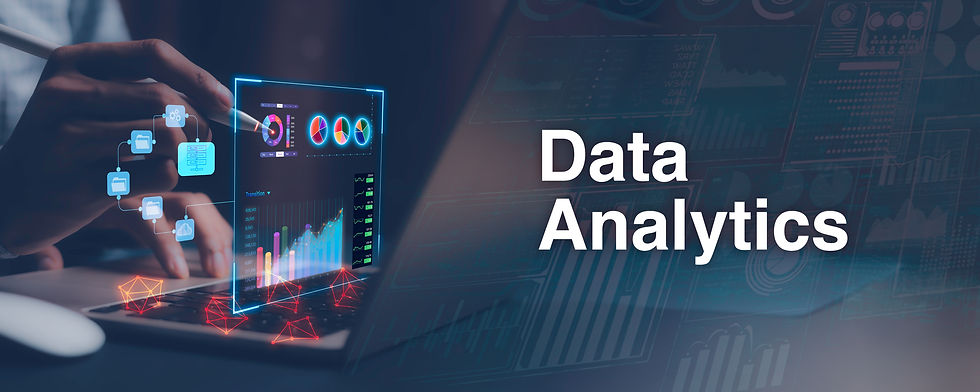Harnessing the Power of Data Analytics: A Detailed Guide
- Purva Yadav

- May 29, 2024
- 4 min read

In today's data-centric world, effective data analysis is a crucial skill. Data analytics involves examining raw data to uncover actionable insights, guiding decision-making across various sectors. Whether you're in finance, healthcare, marketing, or technology, data analytics can revolutionize how you approach challenges and opportunities. This detailed guide will explore the fundamental concepts of data analytics, its tools and techniques, and how to leverage it for impactful results.
Understanding Data Analytics
What is Data Analytics?
Analyzing, cleaning, manipulating, and modeling data in order to find relevant information, make inferences, and aid in decision-making is known as data analytics. It encompasses a range of techniques and tools that help make sense of data, from simple statistical analysis to complex machine learning algorithms.
The Importance of Data Analytics
In an era where data is abundant, extracting meaningful insights from this data is vital. Businesses use data analytics to understand customer behavior, improve operational efficiency, drive strategic decisions, and gain a competitive edge. For example, retail companies analyze purchase data to optimize inventory levels and enhance customer experience, while healthcare providers use patient data to improve treatment outcomes.
Types of Data Analytics
Descriptive Analytics
Descriptive analytics answers the question, "What happened?" It involves summarizing historical data to identify patterns and trends.Data mining, data visualization, and data aggregation are some of the techniques. Dashboards and reports are commonly used to provide an overview of past performance.
Diagnostic Analytics
The question "Why did it happen?" is further explored through diagnostic analytics. It focuses on understanding the causes of trends and patterns identified in descriptive analytics. Techniques such as drill-down, data discovery, and correlations are used to uncover root causes and anomalies.
Predictive Analytics
Predictive analytics uses past data to project future results. It uses statistical models and machine learning algorithms to predict trends and behaviors. Techniques include regression analysis, time series analysis, and classification. This type of analytics is widely used in areas like financial forecasting, risk assessment, and marketing campaigns.
Prescriptive Analytics
Prescriptive analytics suggests actions to achieve desired outcomes, answering "What should we do?"It recommends certain tactics by combining information from diagnostic, predictive, and descriptive analytics. Techniques include optimization, simulation, and decision analysis. Prescriptive analytics helps organizations in resource allocation, scheduling, and strategic planning.
Key Tools and Techniques
Data Collection and Cleaning
Data collection involves gathering information from various sources such as databases, spreadsheets, sensors, and web logs. Once collected, the data often needs cleaning to remove inaccuracies and inconsistencies. Tools like Python, R, and Excel are widely used for data cleaning and preprocessing.
Data Visualization
Data visualization transforms data into visual formats like charts, graphs, and maps, making it easier to understand and interpret. Tools like Tableau, Power BI, and matplotlib (a Python library) are popular for creating interactive and informative visualizations.
Statistical Analysis
Statistical analysis involves applying mathematical techniques to summarize and interpret data. It includes measures such as mean, median, standard deviation, and hypothesis testing. Software like SPSS, SAS, and R are commonly used for statistical analysis.
Machine Learning
Without explicit programming, computers can learn from data and make predictions or judgments thanks to machine learning. Techniques include supervised learning (e.g., linear regression, decision trees) and unsupervised learning (e.g., clustering, dimensionality reduction).TensorFlow, Keras, and scikit-learn for Python are popular tool
Big Data Technologies
With the explosion of data, big data technologies have become essential. They enable the processing and analysis of large datasets that traditional tools cannot handle. Technologies like Hadoop, Spark, and NoSQL databases (e.g., MongoDB, Cassandra) are instrumental in managing big data.
Applying Data Analytics in Real-World Scenarios
Marketing
In marketing, data analytics helps in understanding customer preferences, optimizing campaigns, and measuring ROI. By analyzing customer data, businesses can segment their audience, personalize marketing efforts, and predict future buying behaviors.
Healthcare
In healthcare, data analytics improves patient care, optimizes operations, and drives research. Analyzing patient records helps in identifying risk factors, improving treatment plans, and predicting disease outbreaks.
Finance
In finance, data analytics is used for fraud detection, risk management, and investment strategies. By analyzing transaction data, financial institutions can detect suspicious activities, assess credit risks, and make informed investment decisions.
Retail
In retail, data analytics enhances inventory management, supply chain efficiency, and customer satisfaction. By analyzing sales data, retailers can predict demand, manage stock levels, and create targeted promotions.
Challenges in Data Analytics
Data Quality
Ensuring data accuracy and completeness is a significant challenge. Inaccurate conclusions and actions might result from poor data quality. Regular data cleaning and validation are essential to maintain high data quality.
Data Privacy
With increasing data collection, privacy concerns are paramount. Organizations must comply with regulations like GDPR and CCPA to protect customer data and avoid legal repercussions.
Skill Gap
Data analytics requires a combination of technical and analytical skills, which can be challenging to find. Investing in training and development programs is crucial to bridge this skill gap.
Conclusion
Data analytics is a powerful tool that can transform how organizations operate and compete. By understanding its core concepts, tools, and techniques, you can harness the power of data to drive informed decisions and achieve strategic goals. Continuous learning and adaptation to new technologies and methodologies will ensure that you stay ahead in this dynamic field. Whether you're a business leader, data professional, or aspiring analyst, embracing data analytics, possibly through a Data Analytics course in Navi Mumbai, Mumbai, Thane, Delhi, Noida and other cities can unlock new opportunities and pave the way for success in the digital age.



Comments